The first documentation of the Glawackus (“Glastonbury” + “Wacky”) was on Friday, January 13, 1939, but from the coverage given by The Hartford Courant, it was clear this creature had been an object of obsession for a bit; the copy read like walking into a cocktail party, or in this case, perhaps a hunting party.
Others have told the story without considering the broader context. It was a hard winter in a region that had, months before, gotten nailed by the Great New England Hurricane of 1938. So, there was this disruption. Beyond that, there was the horror show abroad. Hitler’s increasing aggression was reported on, if not daily, often enough that it was a known matter of interest and anxiety. The Kristallnacht riots happened in November 1938. Time magazine named Hitler their “Man of the Year” for 1938 in the issue released January 2, 1939.
In this age without the Internet, people would not have had access to the easy kind of entertainment that allows one to mentally check out until Netflix asks if you’re still watching.
We know that The Year Without A Summer helped create Frankenstein, and long after, continues to inspire art. I’m not saying that any of those traumatic events of the late 1930s were responsible for the birth of Glawackus, but I’m not not saying it.
Before The Hartford Courant had printed anything else about the creature, it presented a coy is it or isn’t it piece titled “Archer Bags Glastonbury Glawackus: But Some Say Corpse Is Of Side Hill Goofus, Best Described in Deathless Poetry.”
The headline alone is nourishing.
First, it was unusual that an archer was involved; every subsequent Glawackus hunter had firearms. Glastonbury had an alarming prevalence of guns and people shooting them willy-nilly. See something by the backyard garden? Shoot at it. Get spooked by your shadow? Shoot at it. Hear about a ferocious critter? Organize hunting parties and shoot at it.
The Glawackus inspired multiple poems, and I will spare you by not republishing them.
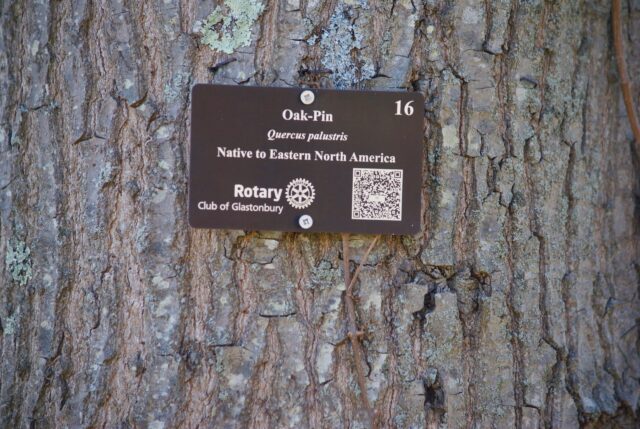
Then, there’s the “Side Hill Goofus” mention, which the best I can make of it is a portmanteau of Sidehill gouger (mammal with uneven legs) and Goofus (bird that flies backwards). Stories of the former circulated for centuries, and it’s not surprising that this knowledge made its way to Connecticut, with the Wampahoofus rumored to be in nearby Vermont. That, and perhaps someone at the Courant got their hands on an advance copy of Fearsome Critters.
So, the newspaper debuted its coverage of the mystery mammal with this: “Outside scientific circles, the beast in the service station is called a side hill goofus, it was explained, and its distinguishing marks are its right legs much shorter than those on the left side. Local experts say it got that way by walking around and around the hills. Sometimes, when frightened, it turns suddenly and spills.”
The other thing that went down just a few months prior to this sighting? “The War of the Worlds” was broadcast.
The oldest continuously published newspaper in the United States went on to say that “Other characteristics: Head of a buck deer, has burlap covered body, and wears trousers, whiskbroom tail, wears shoes and rubbers; known to eat bait from fishermen’s hooks.”
And journalists wonder why the public just gets its news from social media now!
#NotAllNewspapers

Over at The Hartford Times (RIP), coverage of the phenomenon began on January 14, and it adhered a bit closer to what we might recognize as journalistic conventions, indicating that the whole Glawackus story sprung from its rival paper, rather than from actual residents.
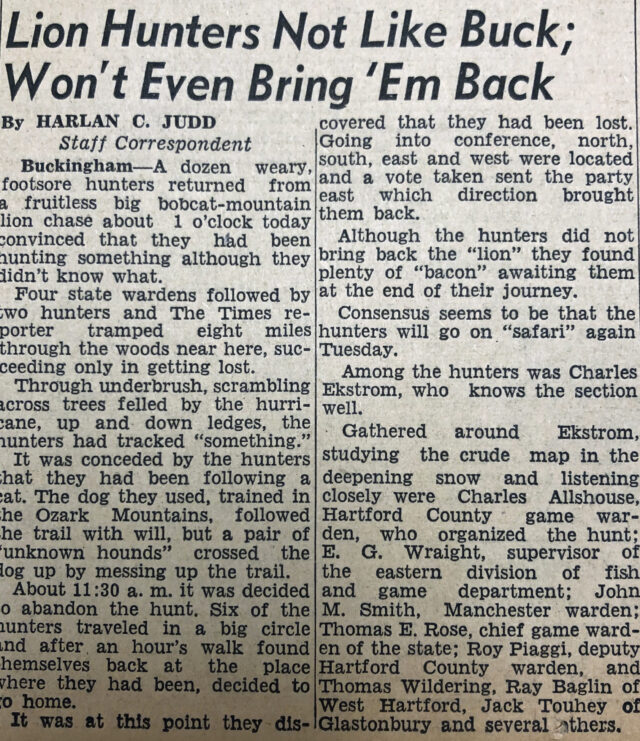
That’s not to say the Hartford Times didn’t have fun with it, reporting that from the Buckingham section of town, a “dozen weary, footsore hunters returned from a fruitless big bobcat-mountain lion chase about 1 o’clock today convinced that they had been hunting something but they didn’t know what.” With four state wardens and the newspaper reporter following eight miles through the woods, half of the hunters were noted as “succeeding only in getting lost.”
The day after, another piece published in the Courant speculated what it was: a catamount, mountain lion, Canada lynx, and bobcat were among the guesses. Just as happens today, there was the kind of quickness to dismiss the possibility of a mountain lion that feels a bit like protesting too much. The most they bend is admitting that it’s “possible that some great creature escaped from a zoo, but until further information comes through, the usual rules of dividing all estimates of size by four should be applied to the stories concerned the Glastonbury what-is-it.”
Let’s not forget that beginning in late May 2011 a mountain lion was spotted in several locations in Greenwich, and within two weeks made its way to Milford only to die – how else? – after the driver of an SUV ran into him on Route 15.
Last week, a friend excitedly (or scared shitless, you decide) texted me that he had just seen a massive cat while biking home at night in a more naturey part of the Farmington/West Hartford area. After giving a size estimate, I was the one who jokingly suggested it was a cougar, and then sent off a picture of one. He said that’s what it was.
For all the folks who want to say something of this size would be more noticed, would it? A massive cat does not behave like a black bear that’ll go straight to flipping trash cans and tangling with bird feeders. Cats are cats, and since their whole thing is creeping up on mice, rats, birds, and whatever else they fancy, they have to be good at going mostly undetected. Is it much, much more likely that the large cat sightings in Connecticut are bobcats? Absolutely.

What of the Glawackus? The Courant had not nearly grown tired of it. A reporter still had headlines to use, like: “Guffaws of Glastonbury Glawackus Greet Gloomy Gang of Gunners.” In that article, the writer enlightened readers: “The Glawackus, by the way, is the animal which has buffaloed local citizens and has given the bird to two organized hunts.”
AI wishes it was that smooth.
The Hartford Times published a photo of game wardens and others standing in the snowy woods, and there’s not much to see there or in the photograph, though its headline explains what it was about: “Hunters Find ‘Country Seat’ of Glastonbury Beast.” They were standing around to look at where a big cat (or something) sat on a log.
The Hartford Times followed this up, now possibly in a headline competition with the Courant, with a piece titled: “Glastonbury Hunters Go Forth to Slay A Lion And End Up By Trapping a Mouse.” On their excursion that began by the “Manchester Reservoir” they spied a mouse, fox, and partridge, but nothing more exciting, which must have been a let down since they had a trained “cat-dog” (dog trained to track large cats, not a cat/dog hybrid) that ended up at a dead end due to “kibitzing hounds” that messed up the scent trail. With a resident having recently seen a mountain lion by her shed in this general area, it had seemed possible the creature was still roaming the woods. There was even an interview before the hunt with those involved, and it was broadcast on the radio.
What makes this day’s activities deserving of ink was some post-hunt happenings that show us how far we’ve come. How far some of us have come. The Hartford Times reported that “at Horvath’s store, where [the hunters] had dined to their heart’s content after the fruitless search Saturday, the lady of the house was too busy doing her ironing to bother with 20 or so hungry men.” But don’t worry, some “women ‘who didn’t want their names in the paper’” – and who apparently had nothing better to do than cater to a bunch of men – “volunteered to feed the pack.”
Days later, a goat disappeared from Hebron Avenue, and the owner, apparently, said it was the Glawackus responsible. Here, we learn that the creature had been blamed for wounding and killing dogs; residents continued to insist it was a “small mountain lion or a large wild cat,” according to the Courant.
The previous day, the game warden exhumed the corpse of dog that had died and been buried two days prior to that. He “declared the animal had been shot on the muzzle by a rifle or revolver. The dog died of loss of blood in the yard of its owner,” wrote the Courant.
That raises more questions than it answers, like, was it just fine for someone to shoot their dog? Was this dog allegedly the Glawackus or allegedly the victim of Glawackus? Both? Neither? And, once more, why the hell was everyone in Glastonbury shooting everything?
The involvement of dogs adds to the confusion because multiple dogs are mentioned over a few years in this story, but reporters generally did not do anything useful like give the date of a dog incident at a later mention. Two dogs? Three? Ten? Who knows!
Around this time, the Hartford Times in a piece that said “Special to The Hartford Times” (special meaning . . .?) reported that in the Matson Hill area, a dog “dragged its torn body home last night, lay down by the woodpile and expired.”
Do we get a make and model of this dog? No, we do not.
We do know that humans followed the trail of its blood “to where the snow bore evidence of a terrific battle, although tracks of many kinds of animals made it impossible to determine what attacked the dog.”
At the same time, a greyhound was injured. This one, whose home was somewhere else in town, seemed to recover from his injuries. It was mentioned that this dog was known to wander to the part of Glastonbury near the dog found dead by his woodpile.
The dog warden determined the injured greyhound likely got his wounds from fighting another dog; a cop thought otherwise.
On January 20, about one week into this whole affair, the Hartford Times caved and while describing what left huge claw marks on a Matson Hill home not far from where that dog was killed, used the phrase “the supposed mountain lion, dubbed glawackus.”

That weekend there were an estimated 200 hunters in the Glastonbury woods on one day, all seeking the mystery animal. On New London Turnpike by Ten Curves (near the Marlborough line) what the Courant called a “slinking animal” was spotted.
The Hartford Times coverage of that Saturday’s hunt says that a Hartford resident, from a mere 15 feet away shot at and missed an animal similar to a black panther. The marksman, they say, was “out hunting the strange animal that has stirred efforts of imagination although causing genuine uneasiness to residents of the Buckingham section.”
Where this article was found in the paper feels completely surreal.
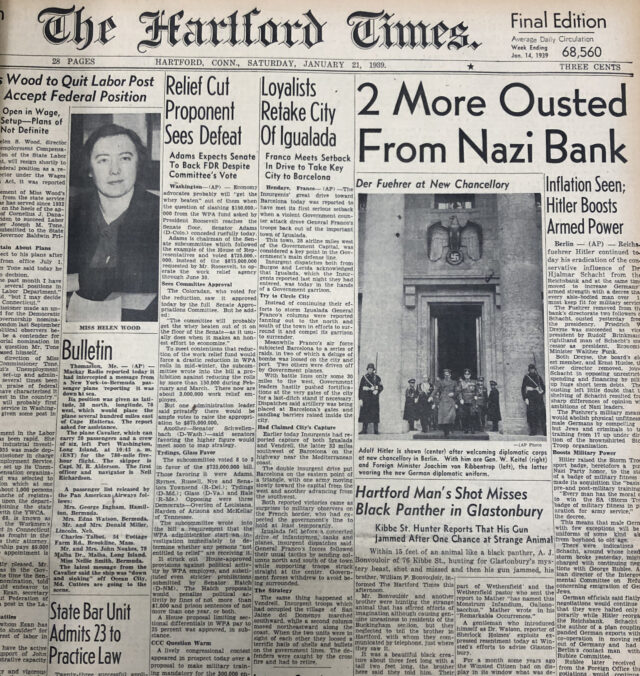
It’s on the front page, tucked in just below the main story about nazis doing more nazi shit. At this time, there was a section of the paper for sports, which this would have fit neatly in, but for whatever reason, it was weighed important enough to get precious front page space – even if below the fold.

There was no new news, but that did not stop the Courant from publishing opinions of people in different parts of the state who had theories on what the creature might be; this was the first suggestion, in print, that the creature was a wolverine. Nobody in those years suggested a fisher.
That same day, the paper published “Not The Gallonbacchus,” a long piece that more than anything else showed how different journalism was then than now, and not just for the satire. Writers expected their audiences to get their meaning. After describing the “Gallonbacchus,” they say that this “monster, may indeed, have been a close relative of the pink elephant and the Brooklyn Boys [referring, probably, to bantamweight boxers]; but the Glawackus is not a lineal descendent of the Gallonbacchus. It has been seen by deacons and its tracks have been smelled by teetotallers who swear that there is no odor of alcohol attached to them.” Eventually, they spell out that the recently exhumed dog – the one shot dead by its owner – was not the victim of the Glawackus.
Another Courant headline: “Glawackus, Lost Until He Saw Map, Gives Exclusive Interview, Wags Tale.” This one begins: “Deep in the Glastonbury woods, where the snows of 1934 (boy, there was a winter) have not yet melted. . . “. In another Courant piece: “the Glawackus eluded them all to disappear into Dark Hollow in the direction of Marlborough. […] it is a tangle of brambles and fallen trees with treacherous rocks and ledges. It is a paradise for Glawackus for it abounds with all kinds of wild game. It is in that country that the famed animal probably will spend his days living to a ripe old age. It is the promised land for the Glawackus.”
At The Hartford Times, the theory of the moment was that “Glastonbury’s fearsome glawackus is merely a big black shepherd dog,” and a local from Matson Hill could prove it. He saw large tracks near the Matson Hill Community House, then spotted a large, thin dog at the edge of the woods, who fled. Upon investigation, the dog’s prints matched the other ones.
The Courant published a map showing the critter’s possible locations:
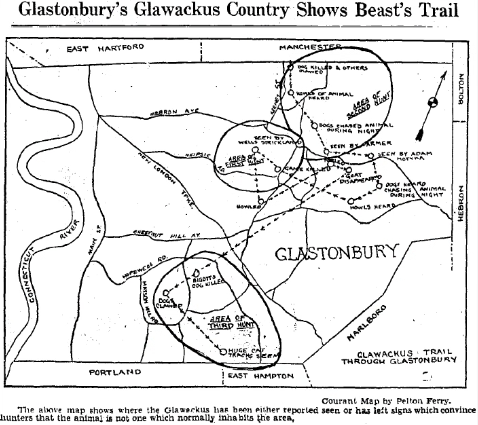
It ran a full page of ads:
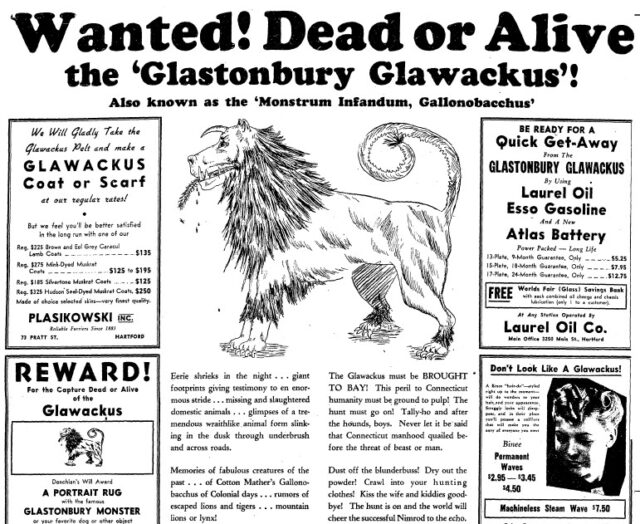
The Glawackus frenzy led to a dance party at the Polish National Home in Hartford, held for Hartford Revolver and Rifle Club members (along with their friends and others), who the following day would be having a hunting expedition in Glastonbury.
The month closed with acknowledgement that the mystery creature provoked the most tourism the town ever received.
In Month Two of the Glawackus, a Glawackus Dance was held at Grange Hall, with free admission offered for anyone who brought a real Glawackus. Was this the beginning and end of the theme? Were there costumes? No idea. Just sticking the name on something could have been enough. You bet that Groundhog Day, ridiculous on its own, was played up even more in 1939.
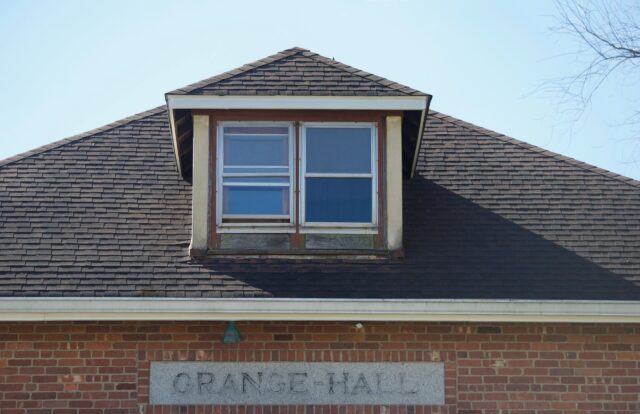
Multiple letters to the editor were inspired by all this, with writers sharing their own theories, and one chiding the paper for “razzing” Glastonbury residents. Meanwhile, the Glawackus was spotted in Mansfield, Canterbury, Scotland, and Portland. The Courant said one was seen in Hartford at Asylum and Main, though by the end of the article, it’s revealed that this “feathered Glawackus” hung from a building’s top floor window was baling wire, cardboard, and turkey feathers designed to scare off starlings.
Not two weeks before, though, The Hartford Times said that the Glawackus was seen in Hartford between the Hartford Electric Light Power Plant and one of the hangars at Brainard Field.
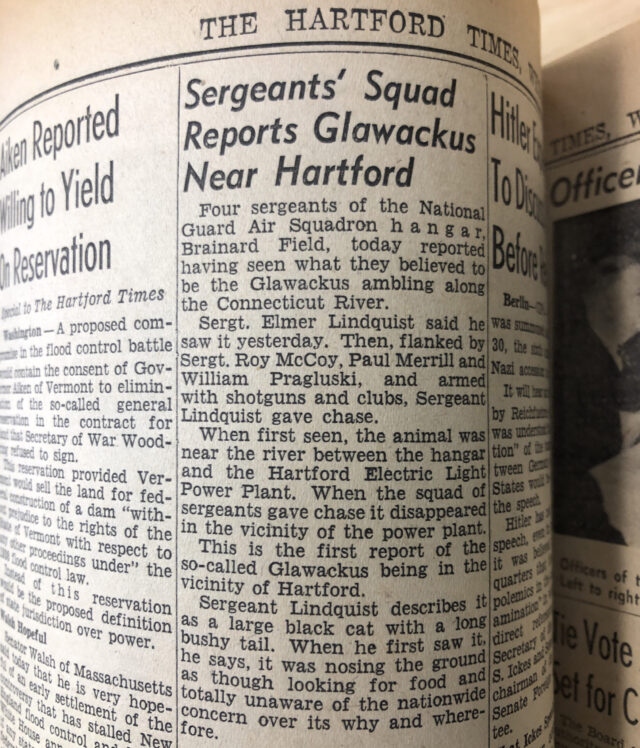
It was described as a “large black cat with a long bushy tail,” and not-fun fact I’ll toss in here to play fair (you’ll see why later), in 1928 the HELCO power station in the South Meadows (photo of remnants below), right on the Connecticut River, began operating what was apparently the first commercial mercury vapor boiler in the United States. Do we think any of that ended up going down river?
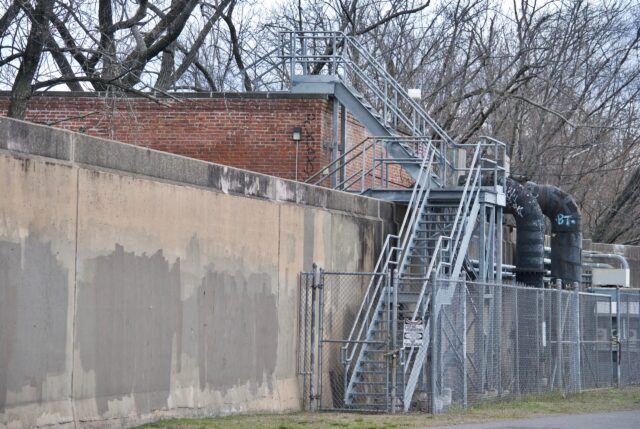
Back to Glastonbury . . . Legislation was introduced. When? That’s unclear, but in February 1939 the Courant published a piece from “The Amalgamated Canine Society of Connecticut” claiming it would “vigorously oppose enactment of House Bill 812 [which] sets aside the Town of Glastonbury as a sanctuary for the Glawackus and other unknown forms of wildlife.” Their objection? “This bill denies us dogs the right to punish a cunning, vicious animal.” Soon after, another Courant piece noted how this bill won’t move forward unless the creature goes before the legislature.
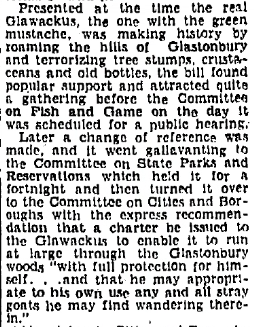
The last I saw mention of this nonsense was in June when Bert H. Kruse wrote about “this chimerical beast” for the Courant; most of the cryptid coverage went published without a byline, so this feels important somehow. Kruse reported that “for a time the House had great sport tossing the famous Glawackus bill back and forth among committees.”
We’re going to do a bit of time traveling. For whatever reason, in 1952, the town landed on Tomahawks as what they would name their varsity sportsball teams. Students dropped their name suggestions into a box and this is what was chosen. By 2012, sixty years in, the name felt over. This was reflected in a burst of newspaper pieces calling it out specifically, and within the larger context of sports teams either appropriating indigenous culture or being straight up offensive. The National Congress of American Indians later contacted Glastonbury asking them to remove the logo. More locally, the Mashantucket Pequot and Mohegan tribal nations gave the mascot/logo a thumbs down. In 2020, a Courant headline finally read: “Tomahawks moniker gets the axe.”
This is where you would expect the story to end, with the replacement of the troublesome mascot/logo. The switch did not happen right away. They still had to choose a replacement name. It was narrowed to Black Bears, Diamondbacks, Guardians, Wolves, and Rattlers/Rattlesnakes. Rattlesnakes would have been the most sensible choice with Glastonbury’s proven rattlesnake population, but staff and students narrowed the selection down to Guardians (?) and Wolves, and eventually chose Guardians in 2021. A student would then draw the mascot. This drawing would be inoffensive and everything would be fine.
Except that there is a population of folks who, after graduation, never cut the cord with their pre-adult life and freaked out. These alumni circulated a petition to keep the Tomahawk mascot. This could have been dealt with easily if the school board issued a statement like “We understand that you are nostalgic for the time when you peaked, but let it go, bro.”
But no, they did what towns do when people come out of the woodwork to protest a bike lane because it might cost them two parking spots: they held a special public meeting. Rookie mistake.
In December 2021, a 53-year old resident noted to smell of alcohol, spoke at the meeting, favoring a restoration of the previous name. That’s putting it politely. After rambling for his permitted three minutes, he grew more irritated when he was informed his speaking time was up. He cussed at board members. The Courant later shared that the “police and the district’s security director determined that [the problem resident] should be watched, but removing him from the auditorium ‘might cause further problems as the crowd seemed to be a bit volatile.’”
Another mistake. Not the last.
The board took a break.
During the recess, one of the board members, also in his 50s, was rightfully pissed at the scene-causing resident, but handled it exactly wrong. He decided to approach the guy and ask if the resident had directed those obscenities at him.
That’s not how to deescalate tension.
The resident literally got up in the board member’s face — during Covid — and if I can decipher the paper’s glossed over description of what was said, called him a pussy.
That is also not how to deescalate tension.
The board member shoved the resident. The resident punched the board member in the face.
What Glastonbury finally got right was that when they voted again, it was 7-1 reaffirming its decision to get rid of the Tomahawk mascot/logo.
Could all of this have been avoided if Glastonbury embraced its Glawackus the way it did in 1939?
Where might you be guaranteed a Glawackus sighting? While Glastonbury went with the Guardians for their sportsball mascot, missing an opportunity, the Hartford Athletic unveiled in 2023 Dillon, their take on the Glawackus. Its authenticity is called into question, if one believes that Glawacki can exist only in Glastonbury, but if that town didn’t embrace the critter for its own mascot, maybe the cryptid moved on, dejected after all these years. How fitting that the Hartford Athletic stadium (pictured below) is just about in the location of where that Glawackus with the black, bushy tail was spotted in Hartford back in 1939.

Returning to that time, there was a lull in Glawackus activity in the Spring of 1939. Maybe people were busy with whatever they do in Spring. Maybe there were more important things for reporters to buckle down and focus on. For all this creature silliness, it stings knowing that once upon a time, the paper was able to report a range of important news stories daily, and then have staff hours remaining in which they could basically screw around with stuff like Glawackus tales.
Then, the dog days of summer prompted a flurry of stories.
“The Glawackus Revealed,” another Courant doing, revealed not much except a writer’s desire to write about something, anything, that wasn’t a crumbling world. I’m guessing. This begins: “The Glawackus, mysterious reports from South Glastonbury assure us, is as dead as Marley, which, as Mr. Dickens took pains to point out, is very dead indeed.”
Is this a new development? A rehashing? Is this the “starved brown dog” killed “more than half a year ago,” and if so, why was the warden only now talking to those who slayed him?
They write that people “caught him in a highly illegal baited bear trap, shot and buried him. He turns out to have been an enormous dog, first cousin by all accounts, to the Hound of the Baskervilles and distantly related to Cerberus who guards the gates to Hades.”
Someone from the Courant took plaster casts of paw prints left somewhere and determined these belonged to a bobcat. How that figures in with this dead dog, who can know.
Now the Glawackus is “the Terror of the Woods,” and the Courant, perhaps paying the writer by the word, closed with: “if Glastonbury had not had a Glawackus, it would have been forced to invent one. It relieved the monotony of a dreary winter. It provided small talk for uncounted dinner tables just as the subject of the hurricane had begun to pall. It got any number of ordinarily slothful individuals into the open air. It did the State a number of other services, not least of which was the romantic publicity it provided in preparation for the vacation season. Now, it is dead, but if one knows Glastonbury, it will rise again. It was too useful to remain long buried.”
In August, we get the big reveal that someone who, at least on paper, seemed on the up and up had been stalked by an animal. As we know from the sea serpent saga, a story is unbelievable until made credible by an upstanding witness, one with “unimpeached veracity.” Who better than someone both active in the Grange and the church?
Let’s meditate on that for a moment. A churchgoer, a believer in God, is considered a fine source for whether or not an animal (or Glawackus exists). In the case of the latter, we are talking about cryptids, and according to the OED, a cryptid is “an animal whose existence or survival to the present day is disputed or unsubstantiated.” That sounds a whole lot like a deity, yeah? The existence has not been proven, but it has not been entirely ruled out either.
So, upstanding farmer Charles G. Strickland shared with the newspaper that a cougar/mountain lion was still in the woods near his place, and he should know better than anyone having had a run in with the creature the previous November. That’s right – finally, after months of reporting, there’s some glimpse at a backstory.
As they put it: “Mr. Strickland recalled the horrific night last November when the beast stalked him as he was wheeling his bicycle up Bush Hill in Manchester.” What beast? The one Courant writers called a “grim, gore-guzzling monster” that was making “blowing noises” at the farmer.
When I read this, I imagined a young guy, maybe in his 20s, coming back from visiting friends or whatever one did in Manchester in 1938. When I found his obituary from 1959, I was stunned: he died at age 89, which means he was no spring chicken pushing his bicycle up the hill twenty years earlier. (His obit said he left a niece, ruling out possibility of this identity being confused with a son given an identical name)
There’s no indication this was a stormy night, but it was dark: “so dark that he couldn’t see it and […] when he got to the top of Bush Hill he hastily mounted his wheel and rode like one possessed. After him came a blood-curdling scream.”
Because the Courant was all about top notch reporting, they also spoke to Strickland’s brother, who “some time ago allegedly saw the monster seated in the woods where he was scratching himself with a show of industry and an expression of great satisfaction.”
You would think that this piece would have stirred up more reaction, but there were perhaps larger concerns pressing.
World War II began the following month. Glawackus was almost forgotten.
It wasn’t until the following July that the Courant dared mention it again, mostly as a recap: “Its disappearance coincided with a rumor that an enormous, half-starved dog had been caught in an illegally set trap across the river and had been quietly dispatched.”
Are those more details about the dog shot in its own yard by its owner?
But they go on: “there are some residents of the town who insist that there was a faint smell of brimstone to be detected in the neighborhoods in which it had made its appearance.”
That’s the part where we circle the sentence in red and yell “SOURCE?!”
Nobody had gone on record previously, at least not with the Courant, with those claims . . . making it seem like part of the legend the newspaper itself was trying to create.
That provoked someone to write in to the paper and suggest they stop ridiculing Glastonbury residents. And then the letter writer schooled the newspaper on how cats walk.
The following month, a woman and her son spotted a large animal at the edge of their garden on Hebron Avenue. As was apparently the custom of the time, the son (age 18), ran into the house to get his gun. The creature ran off before shots were fired.
The year after was also fairly quiet. There were possible sightings in West Granby and East Hampton. But, the Glawackus wouldn’t be put down so easily, not when someone remembered that the Town offered a $5 reward for the Glawackus, dead or alive. In August 1941, a hunter from South Windsor killed a feline near Town Woods Hill in Glastonbury, and as one does, rolled up to Town Hall with the corpse, demanding his bounty.
Wait, it gets worse.
There was some debate about whether or not this was the Glawackus, and you can guess the final verdict, but there’s the stuff in the middle, and it involved someone in Town Hall suggesting that they “cut the ears off the critter and to hold them until some decision was made on the bounty,” the Courant reported. “The ears were lopped off and on Monday night reposed on the desk of Selectman Potter who is all ears for suggestions.”
It would be a week before the decision was made, but two more articles were published in between because how could the Courant pass up milking its cash cow? One of these did little more than establish a theory that the deceased and dismembered animal was a “cross between a wildcat and a domesticated tomcat who stepped out nights.” The following day, another put that more poetically, calling the feline “the outcome of a misalliance between a wildcat and some neighborhood tomcat.” Here, they shared that the cat was over 20 pounds. Finally, the Fish & Game Department ruled that, based on its teeth, it was a plain old cat. Here, the paper tells that those familiar with the area knew of what we would now call a feral cat colony.
That seemed to be the end of the Glawackus sightings in Glastonbury, but that didn’t mean he didn’t get around, or, get to be used to grab attention. Four summers later, a Courant headline read: “Sea Monster Caught Near Boston. No Glawackus Relationship Noted.” “Glastonbury is a preserve,” they explain, “for all Glawacki, whether finned, furred, flippered, or feathered. No Glawackus is genuine outside of town limits.”
I don’t think that legislation ever passed, but maybe there’s an unspoken rule in town that outsiders are not privy to.
Out in Mansfield, in the summer of 1954, there was a sighting by the “Mansfield Hollow Dam project.” The Courant headline: “Mansfield Cat ‘Size of Great Dane’ Called Cougar, Illusion, Glawackus.”
At the start of 1956, a Courant headline read: “Pterodactyl Season Opens After 500 Million Years.” She, and everyone else in Connecticut, must have had cabin fever because there was a pterodactyl hunting day in Glastonbury. Her coverage included gems like: “Ptake to the hills men – the Glastonbury pterodactyl is still at large.” Included in the hunting party was one who was “reputedly the last man to have seen the legendary Glawackus, a huge, cat-like creature whose eyes glow fiercely after dark. The Glawackus was never caught, either. At last report, it was in the middle of the Connecticut River, sinking slowly.”
This pterodactyl did not get as much ptraction as the Glawackus, perhaps because the latter was based on actual animal sightings (cougar/large bobcat/panter/large dog) and the former was entirely, as far as I can tell, for shits and giggles.
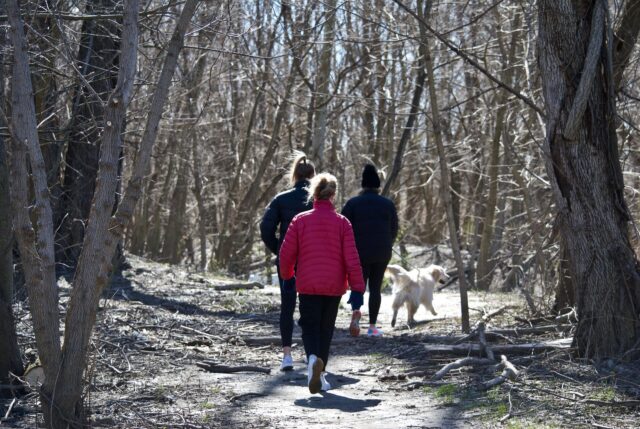
When I took the 95 bus to Glastonbury Center, I was not expecting to see a Glawackus – as much as I want to believe.
Are there secrets yet to be discovered on a planet where privacy dissolved the moment people consented to carry computers in their back pockets?
Absolutely.
In a time when people are quick to air their dirty laundry (or, as they call it now, “be vulnerable”), it’s refreshing for some mystery to persist, whether that takes the form of a deity or a creepy creature stalking what little woods remain in Connecticut.
The problem was that all the Glastonbury Glawackus sightings had been in heavily wooded areas or adjacent, and the public transportation system is not generous enough to serve those parts of Glastonbury. It’s a hilly, not particularly bicycle-friendly community, so even if I wanted to put my bike on a bus and try to reach the sections out along Manchester, Bolton, Hebron, Marlborough, East Hampton, or Portland, I would have been too annoyed by the exercise to feel like searching for anything except my lost sense.
Instead, I was able to roam Glastonbury Center and some of the area along the Connecticut River.
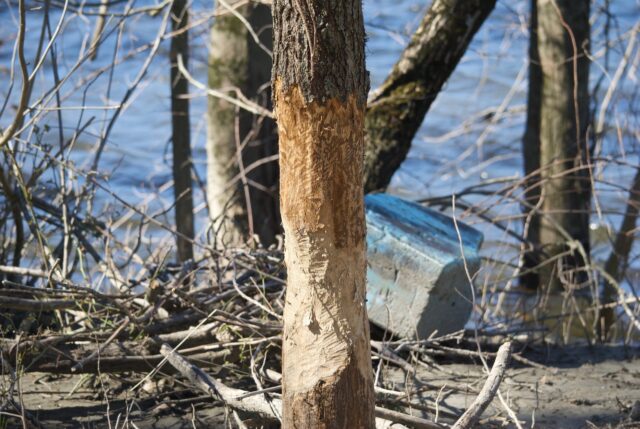
Most of this was not new territory for me, but I also can’t say I visit this town often. The public transit accessible sections feel like the east of the river version of West Hartford in many respects, and bus service to WeHa is faster and more frequent.
There are a few distinguishing features, however.
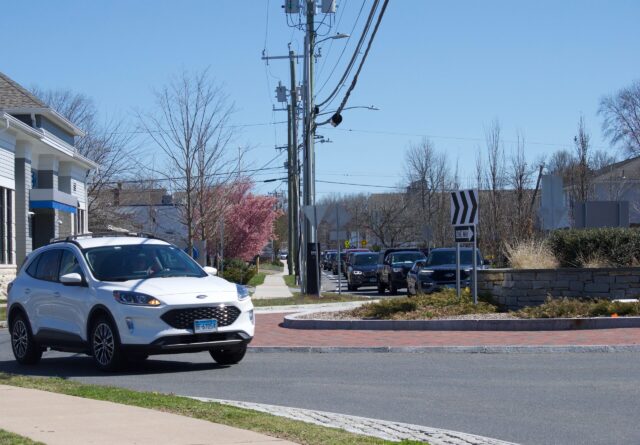
One: they dropped two roundabouts on Hebron Avenue recently and they are effective.
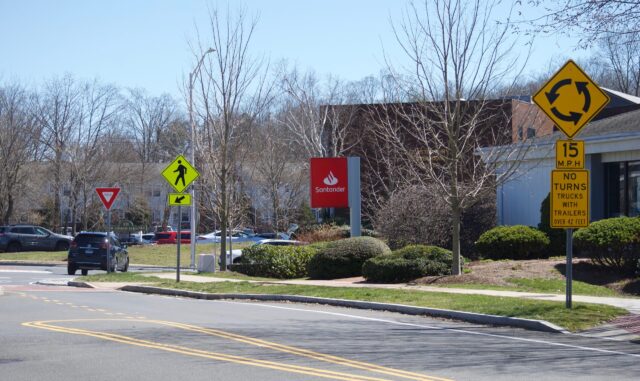
Two: Main Street is not an aggressively awful design. I watched drivers consistently come to a full stop for pedestrians in mid-block crosswalks, unsignalized intersections, free walking, you name it. There’s still room for improvement, but it has a major walkability edge over West Hartford Center in this respect.
I did not come here to look at roundabouts. I was seeking a slight change of scenery, and so after a here-there-and-everywhere bus trip, I made my way to Glastonbury’s riverfront.
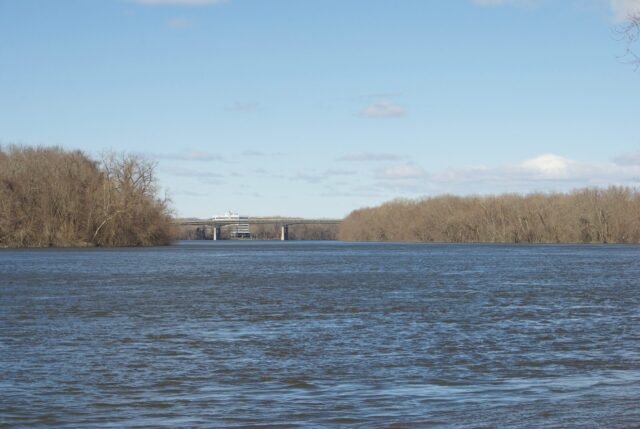
The last time I came to the boathouse I approached it while pedaling north, on the later part of a too long bicycle ride years back. I knew where it was, but not how it looked now, on foot, and coming from a different direction – one I chose because it would have me pass the Grange Hall on Naubuc Avenue. The hall, at the time of the Glawackus Dance, was a mere decade old. The exterior seems to have changed little, but now it is the Glastonbury Theater, a rentable space for weddings, arts events, or what have you. There is nothing stopping someone from recreating that 1939 dance.
Another wedding etc. venue, the Tiffany Juliet House, is just down the road a bit, for those who prefer Victorian to no-frills brick construction. There’s an odd business here and there, and then the vibe changes. There is green space that looks as if one could perhaps use it, but maybe not. I saw no signs at the edge saying it was a park, and also, no No Trespassing signs. So, I decided that if this is not where I was supposed to be, I would be doing a favor for some bored resident with nothing better to do than report trespassers to the police.
The field doesn’t look like a place to be, but after a few minutes I saw people walking along the edge on a gravel path.
I don’t know the rationale for Glastonbury’s dislike for posting useful signs, consistently, in entrances to public spaces, but I do know why the field’s vibes were off.
It’s haunted.
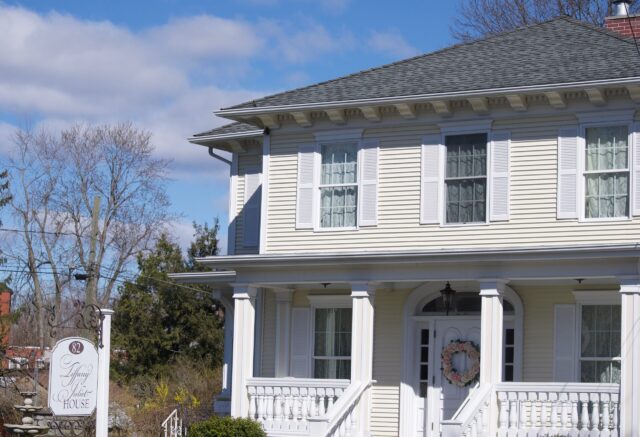
In 1951, the Planning & Zoning Commission approved a rezoning request, making a six acre parcel on Welles Street shift from residential to industrial. It had previously been industrial, home to the Riverside Paper Company and a Hartford-New York steamship dock. The expectation was that a Manchester resident was going to construct “several large fuel oil tanks” on the property at Welles and Phelps Street.
According to the Courant, each tank would have the capacity to hold 500,000 gallons of fossil fuels, and there would be six tanks total.
Right in the town center. Right by the river. That wasn’t an oversight; it was intentional. Oil would be arriving by river barge.
There’s nothing to suggest that this was cause for the pterodactyl hunt a few years after, nor cause for any deep soul searching at the time.
The problems caused by this zoning decision were some of the ones you’d expect, and then some bonus issues. Nobody could have, in 1992, anticipated teenagers ignoring a No Trespassing sign on a chain across the dirt road leading to the seldom used dock, especially when the security guard shack was unattended. Dangerous cargo and open flame did not lead to the death of one; it was more basic: falling backwards off the dock into the Connecticut River in December. The 17-year old boy, found under the dock hours later, died.
The following year, the petroleum company ceased operations and seemingly abandoned the site. You might be asking, did they take the six fuel tanks with them? No, partly because they had more than those initial – and inappropriate, as they were – six tanks.
It came out in 1997 that the owner of the property – now 23 acres – was the former Gov. Weicker’s chief of staff. There is inconsistent reporting within one Courant article about the exact number of tanks and drums on the property: a dozen tanks and four drums or 22 tanks and drums. More than six. Some of the tanks were described as larger than buildings.
Then, so cute, there was a claim that no oil had leaked from the tanks, though they contained “oil contaminated with lead and chlorinated solvents, and oil hard as asphalt.”
There’s more to it than that. In the early 80s, a company purchased the land from the original fuel company that owned it; then, in the early 90s, there was another property transfer, and for about one year before closing, this business used the property as a waste oil collection point. Waste oil from oil companies was deposited here with the intention of converting it for industrial energy use. All of this right near Glastonbury’s town center.
It took over 45 years before any apparent concern about environmental impacts of huge fuel tanks, but now, they knew that at least 3,000 of the 50,000 gallons of oil were hazardous according to the EPA’s Superfund Removal Program, and the paper wrote that the “State DEP has been aware of a violation since 1994.” Because media rarely agrees with itself, another article said that the DEP (now DEEP) in 1994 claimed that upwards of 96,000 gallons of used oil contained hazardous materials.
The town foreclosed on the tank farm in 1998 and the tanks were removed in 2003, which is when the removal of 7,600 tons of contaminated soil from site began. Sounds like something leaked, after all. There were concerns about all this polluted material being trucked through town and where it would go.
Eventually, people were told that the 500 truckloads were being taken to an out-of-state facility.
Away.
Something we have gotten better about understanding more recently is that when managing disposal of plastic, toxins, whatever, there is no away. Someone will have to deal with it. It’s true of the household waste that is no longer being incinerated in Hartford (for us to breathe) and it was true of this amount of fossil fuel.
So, if you find yourself standing at this lawn, wondering why it seems off, you now know it’s because in 1951 and at many points since, the town just shrugged and was like “polluting substances right by the river? Go for it.”
The community center groundbreaking was in 2003 and ribbon cutting in 2005. Part of the delay was that during construction, a 40,000 gallon underground fuel tank was discovered. Surprise!
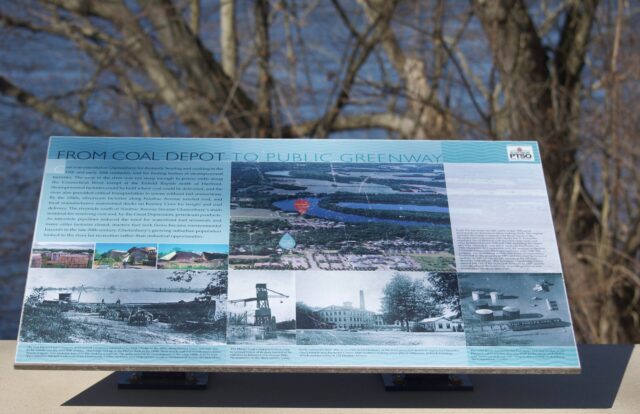
Now, the park had a stone dust trail from Main Street to a field, and work would continue more smoothly for the next couple of years. Riverfront Park officially opened in 2007, even though the Apple Harvest Festival had happened on the site for three years already.

There are the obvious stone dust paths, and they feel fine if your entire goal is just to walk around, but for river views, you have to really be up by the boathouse or start using the trails that are maybe not official. I overheard a group of people starting out on one commenting how they didn’t know if this trail went anywhere. It wasn’t only me feeling clueless.
On an unmarked trail I found the kind of bridge I would make as an Eagle Scout project, and while not overly wide, a mostly maintained path. This is where the more interesting and less obstructed river views are to be had.
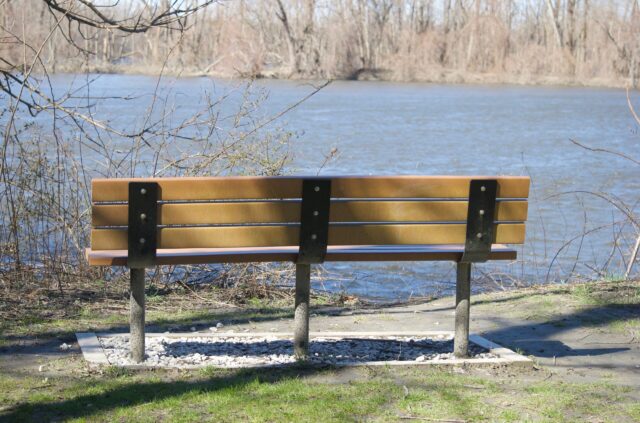
Until reaching this very official-looking bench, I continued to feel unsure if the path I followed was official or not. I liked that I managed to move off the more beaten path, away from the sports fields, and into an area where it felt like I might even see deer or fox. Something.
Unfortunately, a large tree was down in the area and with the wind picking up, I thought better of continuing through the woods.
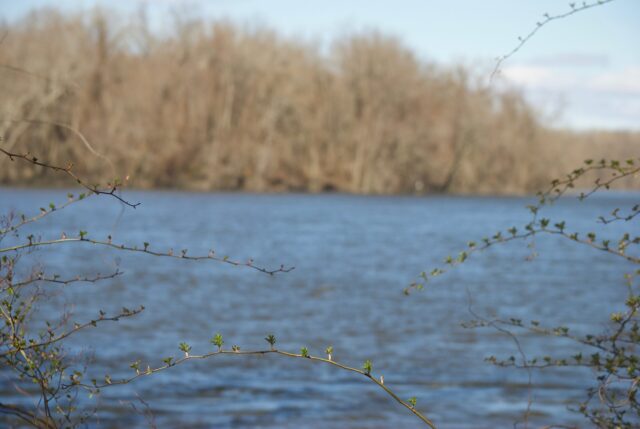
Behind me I could see a bit of a clearing, so I walked in that direction, assuming it came out somewhere. When I reached the top of the hill/dike(?),I was greeted with this view of the wastewater treatment facility. It didn’t smell, at least.
From there, I had to guess my way around. The lightly worn path at the top of the dike suggested others had gone this way and found a way off eventually, so I did that, and can assure you I am not typing this from atop a hill where I now live because I can’t find my way down.
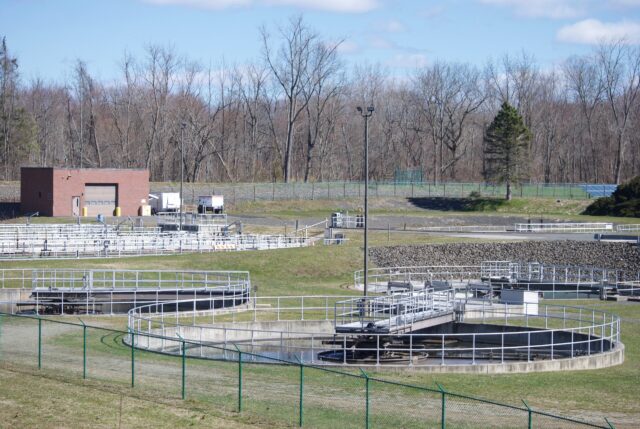
It actually came out not far from one of the stone dust paths, so I joined up with it and guessed my way around until I wound up exiting it behind the whole town hall/wastewater area and parking lot. I finally located a map, which was even more faded than it appears in the photo below — I boosted the color in editing so that it was viewable at all. I still don’t know if what I walked on was an officially maintained path, but found out that the stonedust one(s) is part of this network of short walking loops in Glastonbury Center. Later, I passed another of the same sign, and that one wasn’t faded.
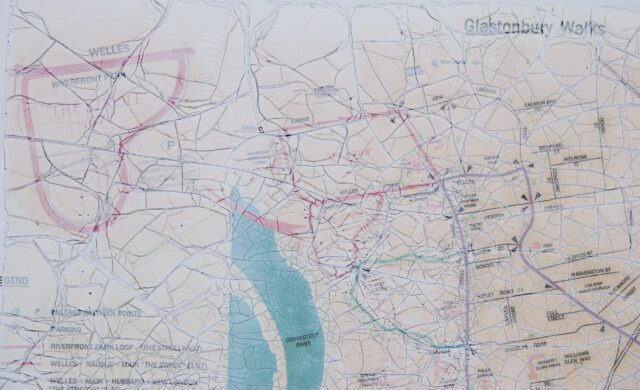
The whole absence of signs, or useful ones, where I wanted them seemed strange to me. I’ve grown spoiled in Hartford, where every park seems to have a sign at every obvious entrance, or maybe to say it another way: if you can access without trespassing, there’s probably a sign nearby letting you know where you are. That’s what threw me about entering Riverfront Park from Naubuc Avenue, and then again when I was on Main Street and looking around to see what signs might be pointing people in the right direction.
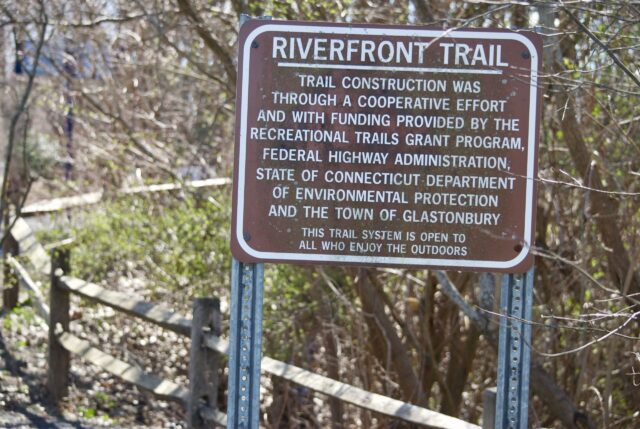
Once inside the park, if you want to know where the dog park is, then you have it made. Someone is catering to this demographic by putting those little dog park signs everywhere.
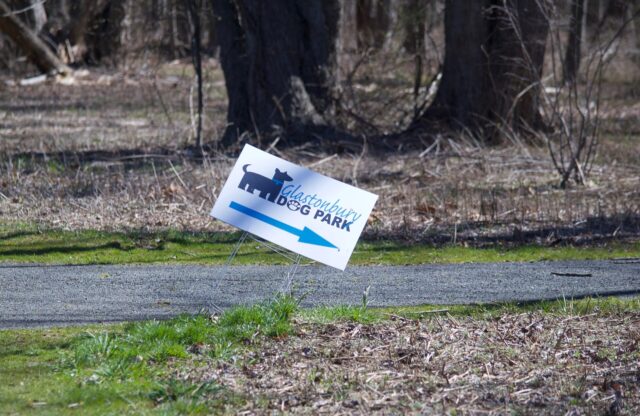
But want to know where public restrooms are? Where a trail goes or what it’s called? You have to work to get that information.
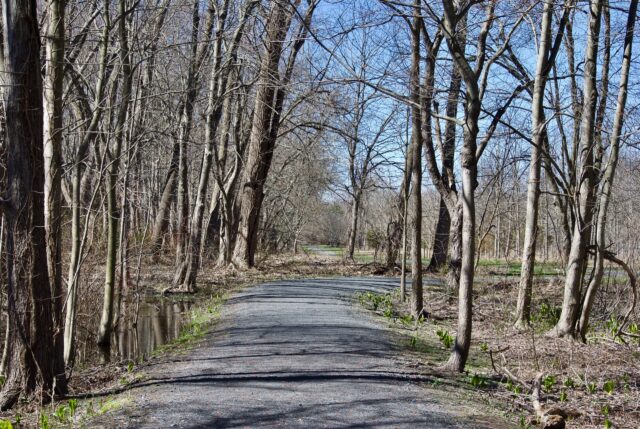
It’s too bad because while Riverfront Park isn’t an amazing wonderland, it’s a decent enough semi-natural place a short walk from bus stops, restaurants, and wedding venues. You don’t have to drive to the middle of nowhere to get a little taste of nature, but it’s almost like they want to keep this a secret.
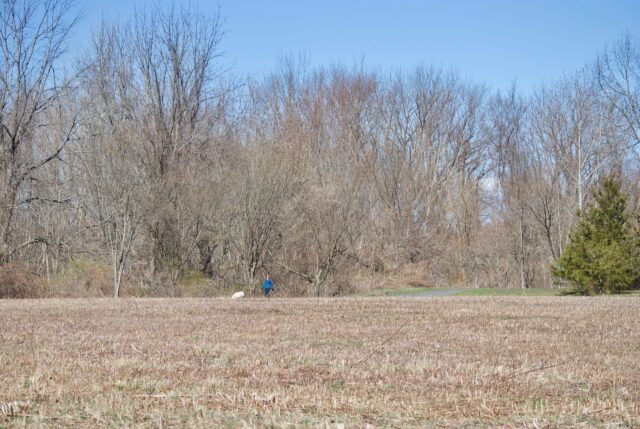
While Riverfront Park was taking shape, the Courant suggested that Glastonbury not only reconnect with the Connecticut River, but that it connect with Hartford and other communities, and it really has not done that.
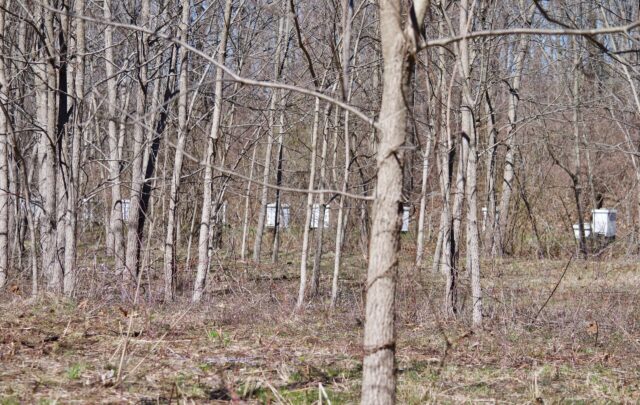
The Town of Glastonbury’s website says it’s a “great place for biking,” but I’m not sure I agree.
That’s not just because back in the 1960s there was an ordinance requiring residents to register their bicycles for 25¢ or risk getting charged with a misdemeanor.
There have been multiple attempts to get some bicycle infrastructure, but they never caught momentum. In the early 70s there was a push for a bicycle network. It was floated out in 1970 by the Greater Hartford Council of American Youth Hostels, who named Glastonbury along with Simsbury, West Hartford, and New London as places that should have bikeways; then, the following year, the Glastonbury Junior Women’s Club were the ones who made a proposal, citing how safer routes would “alleviate the need to transport children by cars, would reduce automobile pollution, increase physical fitness, and benefit group cycling programs.”
Judging from the expansion of Route 2, I’m not sure that reducing tailpipe exhaust was a convincing enough argument at the time.
Back in 1976, the town sought a federal grant to build a 20 mile bike route. This seemingly went nowhere. A long silence followed, presumably because everyone was Jazzercising their way through the following decade.
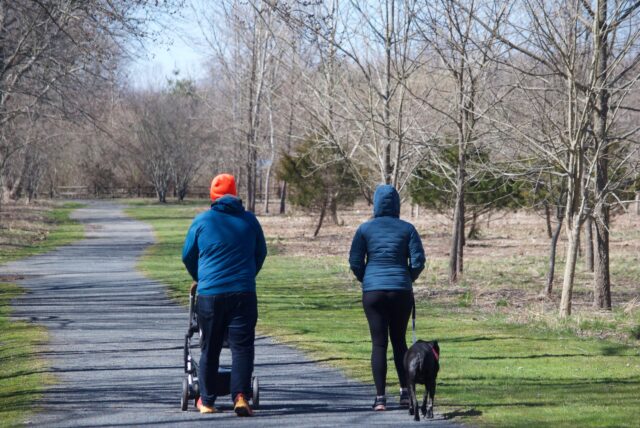
The only thing slower than removing fuel oil tanks from a town center is creating safe and convenient bicycle routes.
Efforts to connect the Arrigoni Bridge to the Rocky Hill-Glastonbury Ferry by bike path stalled out because this would have harshed the mellow for hunters. By the mid-1990s, there was to be consideration of a bikeway program including acquiring the right of way for a 12-mile trail, with funding approval to begin construction of the first three miles. Crickets.
Ten years later, the town council marked $50,000 of the capital improvement project budget to begin work on a bike trail through town; that was reported for a budget not yet approved. The aim was to go from the Manchester line (truly vague) to the Rocky Hill-Glastonbury ferry. I don’t know if you know anything about money, but $50,000 for a bike trail feels like me attempting to buy a martini for a quarter. Nice try, come back later.
Honestly, at this point, I’m feeling like it’s more likely I’ll see Glawacki than bike infrastructure here.
In 2006, the town created a bicycle master plan — 24 pages — and there was talk of the first mile of bike path being a connection between Smith Middle School and Bell Road. It wouldn’t be until the following year that they got $600,000 for that project, which eventually they hoped to connect with Riverfront Park. Something went off the rails because in 2010, there was another article, this time saying the the $1.3M plan for building this trail was finally approved.
This is what happens when we delay projects — the size of the projects shrink and the costs go way up.
This was also a questionable choice. They could have restriped Hebron Avenue and installed dividers to create a safe space for cyclists, but instead opted to cut a path through a natural area rather than remove anything from automobiles.
This middle school bike trail (Smith School Greenway) opened in 2012; the half mile Salmon Brook Trail opened in 2020. I don’t see any signs that the Smith School Greenway is truly connected to the Riverfront via other bike paths. At a glance, there’s a map showing a winding route that seems promising, but some of the route has cyclists on streets or sidewalks; it’s not a consistent network of actual paths. This is the standard patchwork approach that nobody would accept if handed to drivers.
If a 12-year old child wouldn’t be allowed to ride a full east-west or north-south route, alone, then we know it’s not an actual bike route and we can drop the façade; that’s true if we’re talking about Glastonbury or West Hartford or Simsbury or anywhere else.
I don’t even want to talk about how delayed the Putnam Bridge bike path project is, though the most recent expected opening date is April 15, 2024.
I can lightly applaud the tiny efforts they’ve made here and there, but I’m not going to act like this is a great place for biking. There were exactly zero bicycles parked outside of the Whole Foods on a Saturday when the store was packed, and for comparison, there are always bikes locked outside of the Whole Foods in West Hartford Center — a town I don’t particularly consider great for biking either, though their Trout Brook Trail has become more useful in the last couple years.
Where I was going with all this is that while there are walking trails and some bike paths, they’re not all marked in ways to help you know where you’re going, and they’re certainly not all connected for utility.
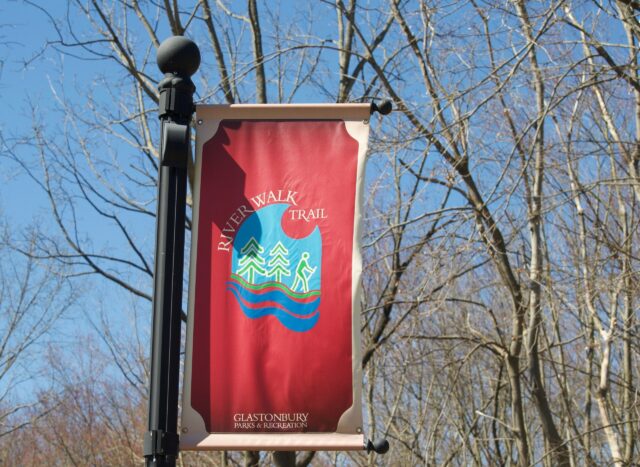
The photo above is what you get for a sign leading into Riverfront Park from Main Street. It’s not out by the road; it’s down in the parking lot, so you have to actual know where you’re going. If you want another landmark, it’s what acts as a driveway on the south side of the strip mall where the Brides To Be store is. Thinks Brides, Bikes, Bogs if you need to remember where an entrance is, and let’s hope the bridal boutique stays there forever.

But, if you can find Riverfront Park whether walking from a bus stop or riding on a disjointed route from a middle school, or even if legally coming from the Putnam Bridge multi-use path, someday, it’s not the worst place to spend some time and have a picnic lunch.
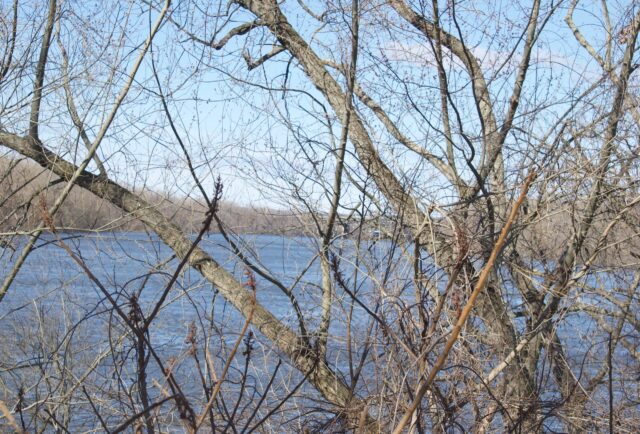
The park, as you’re seeing, was not completed all at once. That was the plan, but it was also not the plan. What was expected as its own phase – building the boathouse, boat launch, playground, fountain, and hiking trails – ended up being two phases: construction and then immediate move into renovations.
If there’s anything that you can take away from this visit to Glastonbury, it’s this: people need to respect nature and ask more questions.

By 2013 the former Hallmark Tire factory was demolished and removed from the area slated for the boathouse and launch. As far as I can tell, no surprises happened here like the underground oil tank, but it feels like not enough attention had been paid to what was underfoot or right beside. There was a grand opening for the Riverfront Park expansion in 2014, and then one month later, it was acknowledged that mistakes were made.
Respecting nature includes not building right up on rivers and then acting surprised when predictable results follow.

In June 2017, when the repairs were finally finished, a town councilman threw the project designer under the bus, telling the Courant: “I’m just saddened our designer didn’t give [a boardwalk] as an option when we first designed the boathouse. I think it’s more appropriate than the concrete.” Nobody working for the Town of Glastonbury thought to ask?! Plenty of design concepts are going to be more wonky than the average person can get their head around, but surely someone in Town Hall had visited a beach and seen boardwalks.
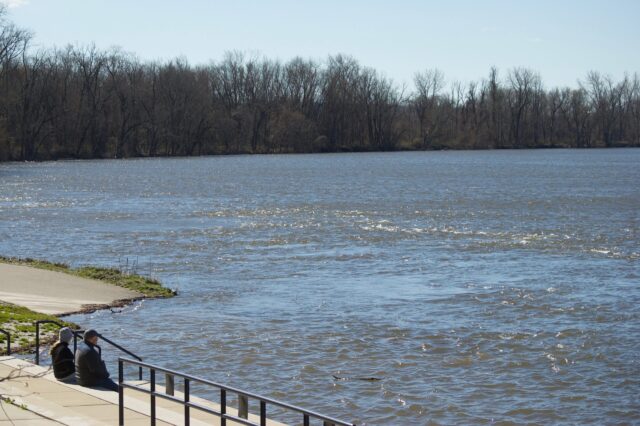
Or, not. So they built a boathouse close to the river and then installed concrete sidewalks and a brick patio, and right after that grand opening, erosion was detected. The shiny new sidewalk had already cracked and gapped. They had to tear out the brand new grass, trees, and sidewalk to address what they were calling “underground water issues.”
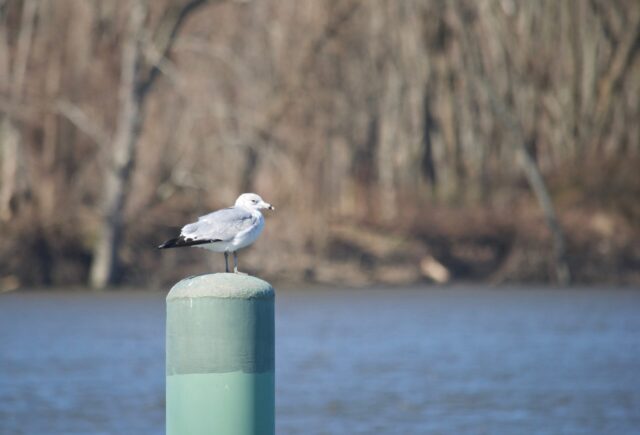
Part of their solution was to install riprap. Riprap is riffraff. There’s a reason that they needed DEEP approval to use it. Riprap, used to stabilize riverbanks, can create other issues; often, it speeds the river’s flow and increases erosion threats downriver. Attention has to be given to its material and installation to minimize negative impacts on the ecosystem. Did Glastonbury make sure all of these precautions were taken during their renovation, or did they push ahead without scrutinizing the new plan? So far, it’s seeming to hold up.
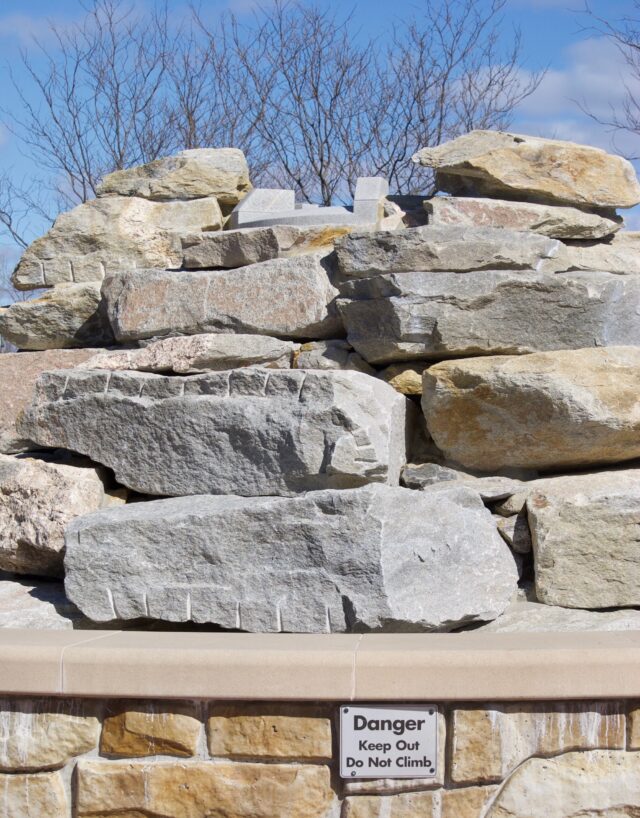
Also holding up: the Connecticut River’s path.
For now.
It seems people look at certain features as having been fixed in place forever.
“This is the way of the world”
“This is how it’s always been”
They either forget or don’t know that change, even with rivers, is a promise.
The Connecticut River has experienced several channel changes since colonial times; one of these is why Wethersfield is on both the west and east sides of the Connecticut River.
Even though it’s considered stable now because of all the upriver “flood control” developments, nobody needs to tempt fate with hubris.
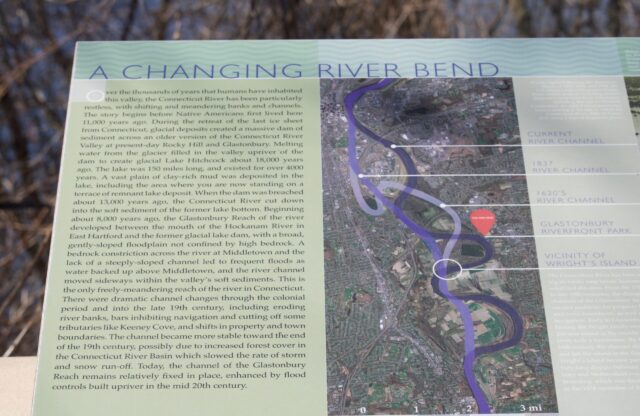
Glastonbury is good for the interpretative signs, even if the directional signs are lacking.
One calling the park an eco-friendly greenspace gave me a good laugh, though.
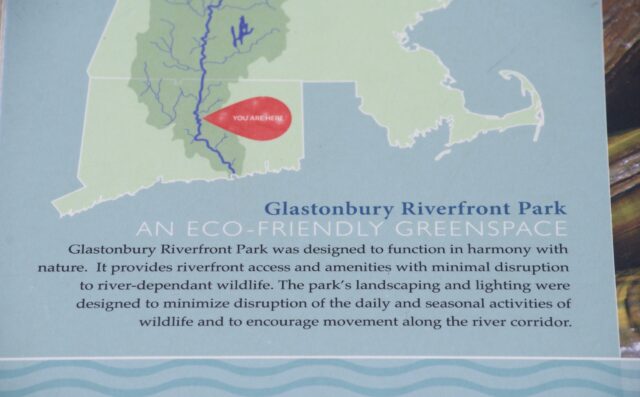
After I snapped a photo of the sign above, I simply pivoted and took the picture immediately below:
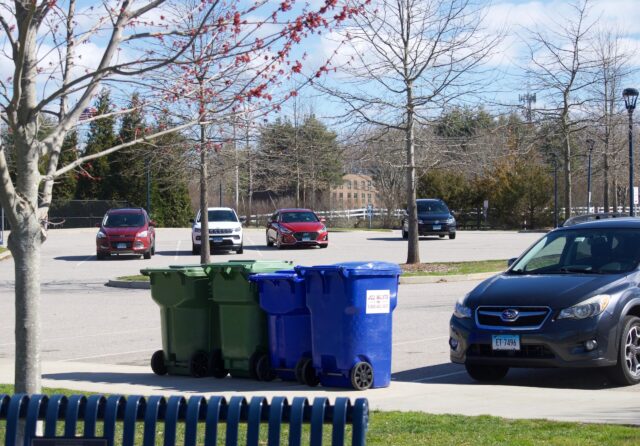
The Town of Glastonbury does not currently acknowledge the possibility of people arriving to the park via bus, bicycle, or on foot in their directions:

As for the parking lot, I failed to see any green infrastructure, but maybe I missed it. Recycling bins don’t count. What’s preventing all the crap that leaks out of cars from washing into the river during heavy rains?
Hooray for the landscaping and lighting, but eco-friendly is a stretch.
I want to believe.
I want to believe Glastonbury can step up its game and turn this park into a truly eco-friendly gem, connected to an honest-to-goodness bike trail that goes to at least where they hoped it would.
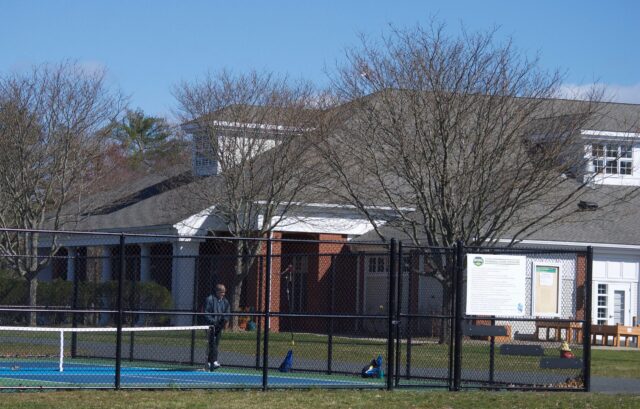
Last July, without decades of planning, the town opened new pickleball courts in Riverfront Park. The costs for developing recreational space like this is lower than for bike facilities that help keep riders alive, but it does show that when someone wants a thing to happen, they can make it so.
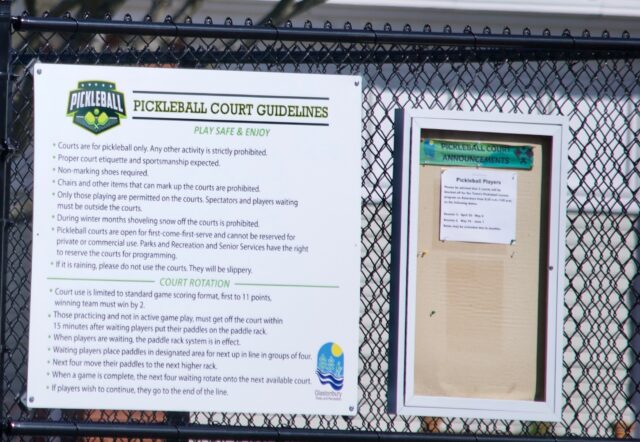
Something that feels more unique to Glastonbury is its Poetry in the Parks.
Plenty of places have taken on some version of enlarging pages from children’s books and posting them low, usually just laminated and zip-tied to a fence.
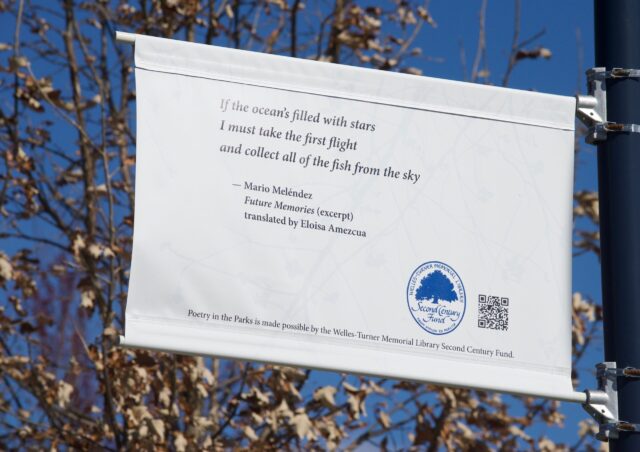
What I like about Poetry in the Parks is that it is not specifically for children.
Passages from different poems — most pertaining to the natural world, but some not — are included at different heights on different sites. At Riverfront Park, the ones I noticed (not all pictured) were on banners that you had to look up to see. Given their theme, it made sense.
The town’s Poet Laureate selected the poems featured for the year, which are scattered throughout this park, Center Green, and in other green spaces like the Ferry Landing River Walk and the Smith School Greenway AKA Smith Multi-Use Trail. A QR code on each sign sends visitors to the full poem.
Too often, it feels like literacy is treated in one of two ways: children get the bright, fantastical (though often condescending) stories, and adults get the dry, just the facts stuff to address their insomnia. This program breaks away from that, respecting everyone’s possibility to imagine.
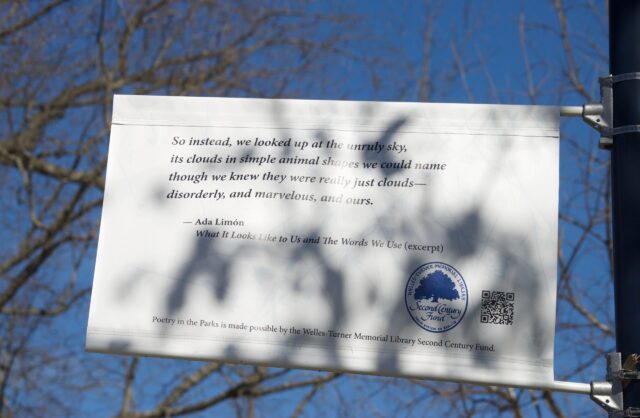
What if our imaginations were fed more regularly?
We might be able to conceive of walkways that are not closed in winter because year-round movement of our bodies is recognized and valued.
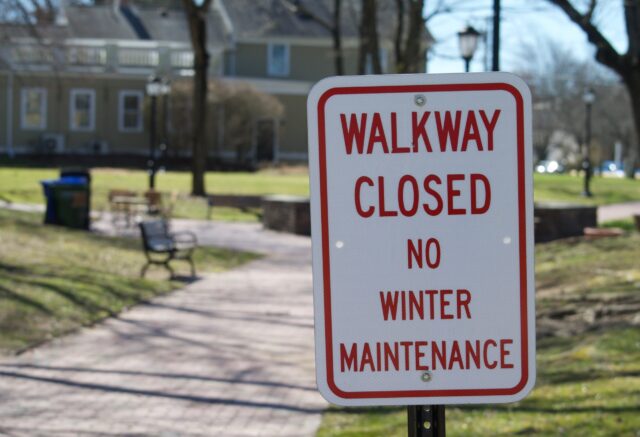
If deciphering wooded trails feels too dicey for you, there are enough historic buildings to view from sidewalks along Main Street and elsewhere in the town center.
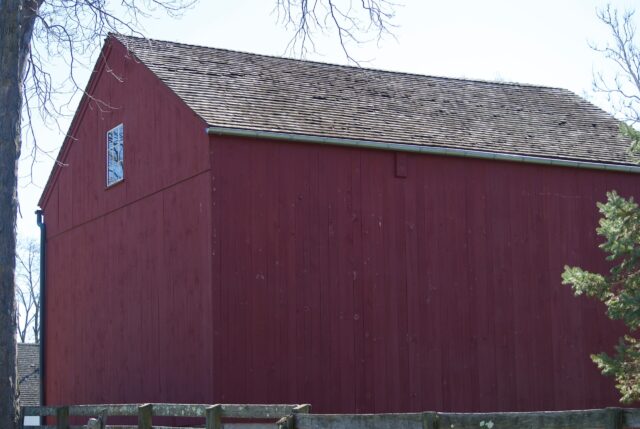
Barn, church, charming inn, all neighboring one another. What’s not to like about that?
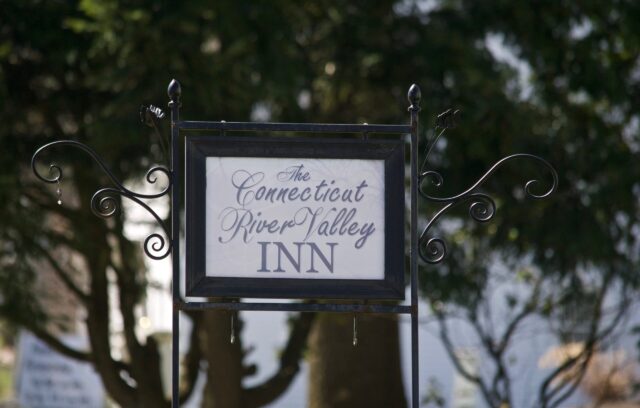
The Museum on the Green — half a mile south of Riverfront Park — probably has information about at least some of the historic buildings; it’s open only on Tuesdays and Thursdays, so I was unable to stop in to verify.
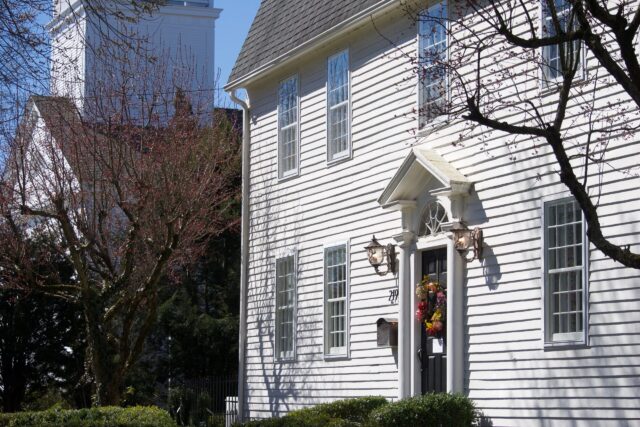
Personally, my knowledge of the cryptid and environmental history of the area felt satisfying enough.
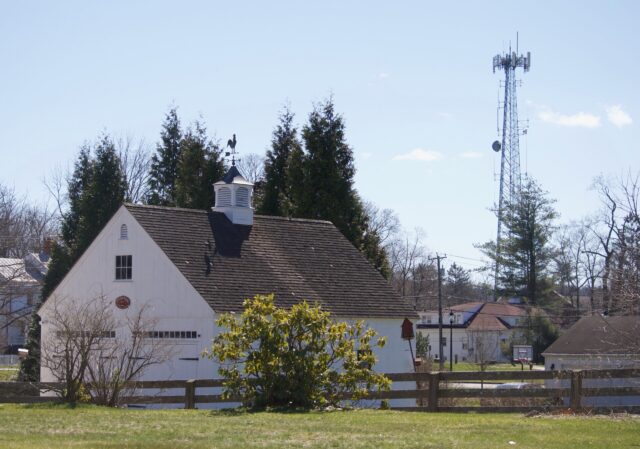
There were many lovely homes and buildings elsewhere, but besides limiting how many photos I would include, some of those structures were made less attractive because of powerlines and/or cars that would be in the picture. This was intended to be an overview and not a comprehensive report on Glastonbury, anyway.
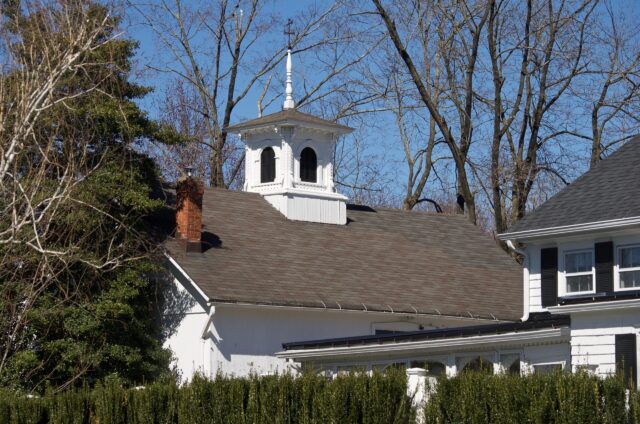
Some may want to know about this, though. The presence of crime watch signs makes me uncomfortable; they suggest some bored busybody is watching me with binoculars, reporting my every move on NextDoor. It’s an actual concern for others who might have the police called on them for being “suspicious”. This feels even less welcoming than being less than open about where a public park entrance is.
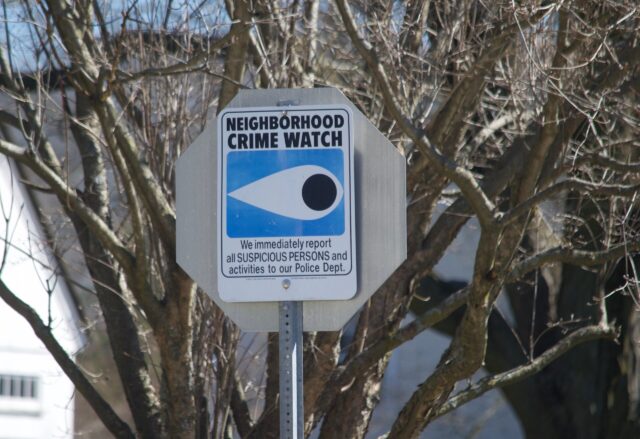
And that’s really too bad, because a person should be comfortable strolling down the sidewalk to view interesting artwork and lovely historic homes. Instead, I found myself wondering how many seconds of standing still I could do before I became suspicious to someone.
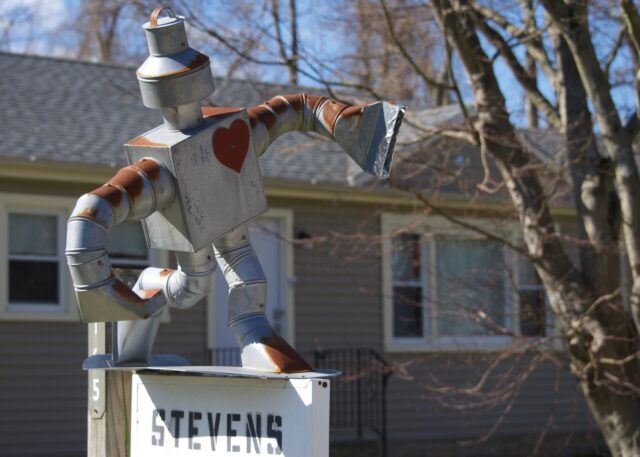
The crime watch signs make me want to parade around in a t-shirt that reads “Calm down, nobody wants to steal your shit.”

While walking with caution, notice how some of Glastonbury’s older homes have been converted to retail use.
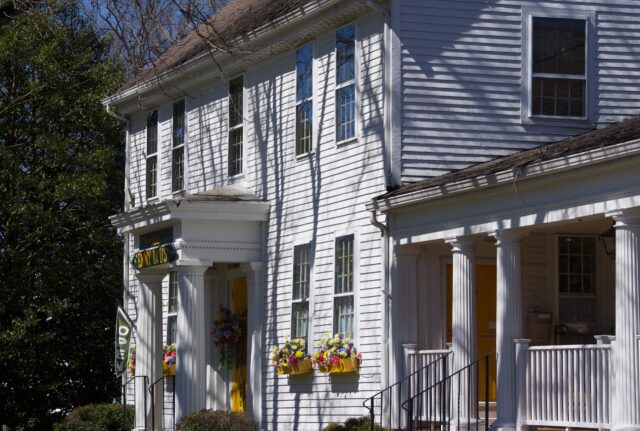
Some, though, are in strip malls.
As much as the Glastonbury/West Hartford mirroring of businesses irks me, there are plenty of independent and unique-to-Glastonbury shops, like Village Wool.
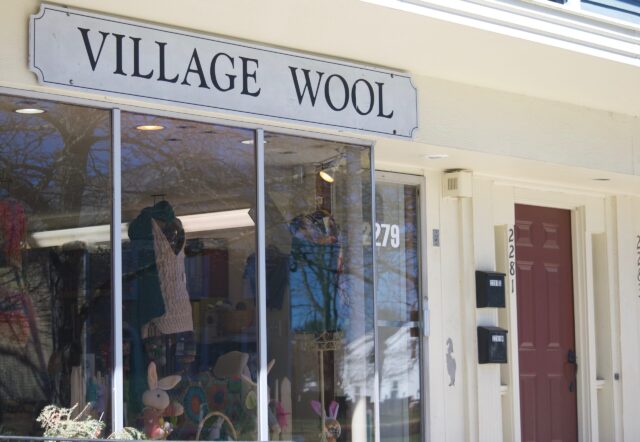
Cycling Concepts is not far from the Riverfront Park path.

I don’t have much need for clothes shopping, so I can’t say I know what is inside this boutique, but I like their committment to turquoise.
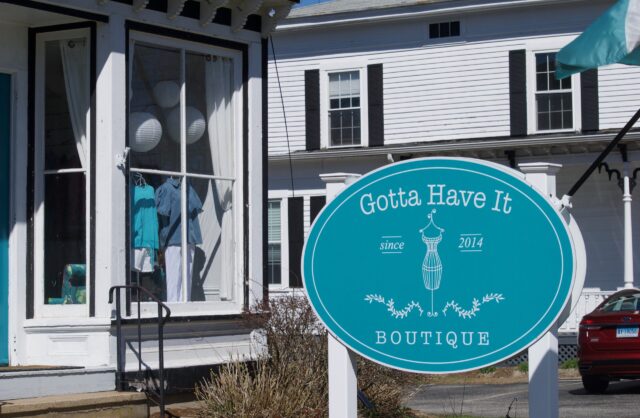
What I can talk about is where to go for food and drink.
In 2020, bin228 on Pearl Street in Hartford closed its doors permanently. It was a lovely spot with great staff, and it felt like a friendly place for women to sit at a bar drinking wine without running into harassment. Four years previously, they had opened what was a second location in Glastonbury, but given that I could walk to the one in Hartford, never bothered to go. Now, I’m happy to visit on the rare occasions that I make it across the river. The strip mall does not have the same charm as the old brick building in Hartford; once inside, that’s a detail easy to overlook. The staff are still as friendly as ever and the menu is close to what was offered in Hartford.
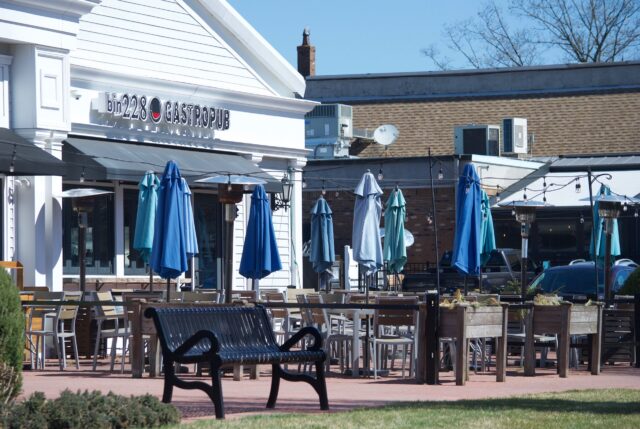
There are multipe bakeries in the center of town, and one food truck specializing in apple cider doughnuts.
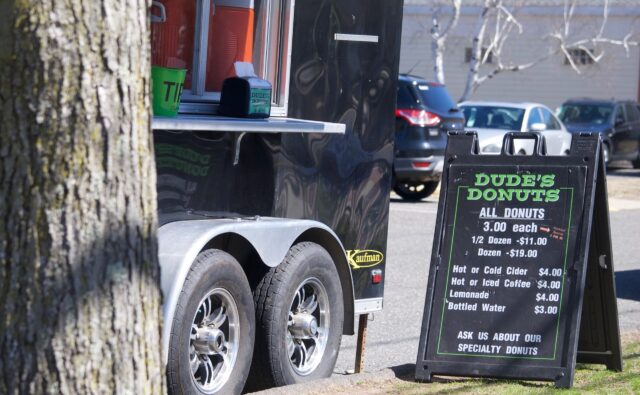
There are multiple places to get coffee that aren’t chains.
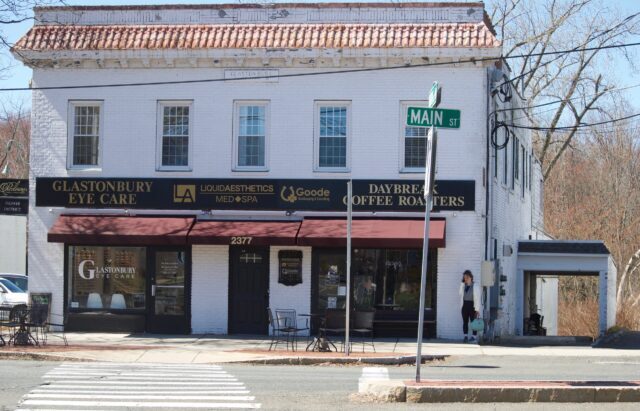
Daybreak Coffee Roasters goes back to 1989, and as a creature of habit, this is the place I’m most likely to stop. It’s on the same side of the street as the walking path into Riverfront Park.

Before hopping on a bus back to Hartford I had one more stop to make: River Bend Bookshop.
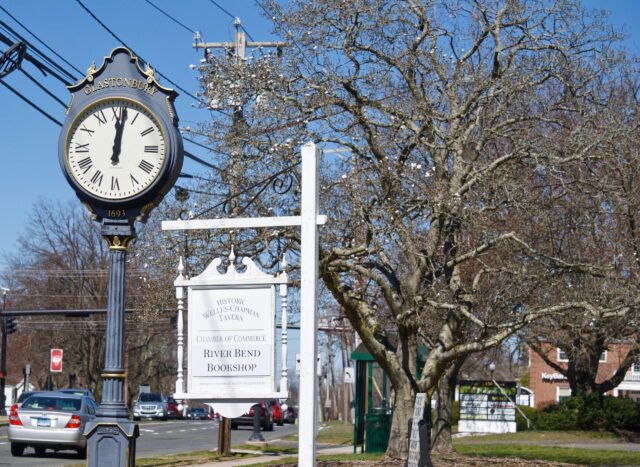
Their original location was in Glastonbury, a five-minute walk south on the other side of Main Street from their new site which they share with the Chamber of Commerce. A little strange, maybe, but there’s more space for books and the building is more attractive.
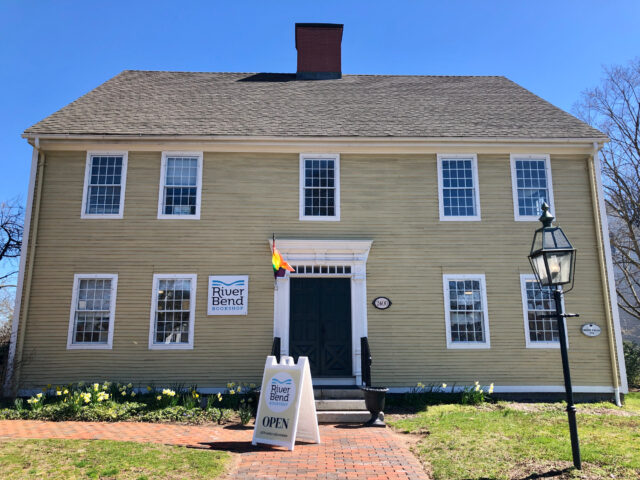
Because I’m a flaming hypocrite, this mirror act with West Hartford does not bother me. They opened their second shop in West Hartford in 2022, and though it’s a little smaller, that’s the one I typically go to because it’s a 15-minute (or less) bus trip; getting to the Glastonbury store when starting from home takes 50 minutes.
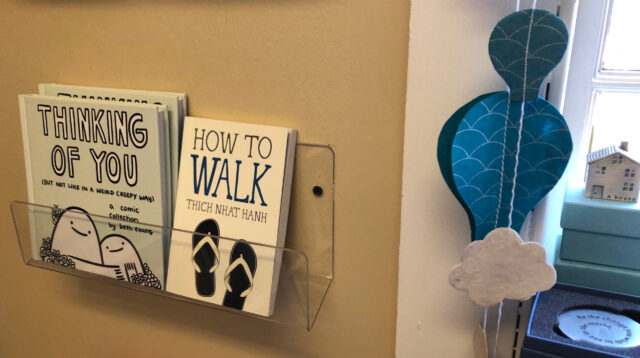
Despite not being a sprawling bigbox bookstore, it’s impossible to leave emptyhanded.

You can find anything here.
Where did I find glawacki in Glastonbury? Inside of a book sold at River Bend Bookshop.
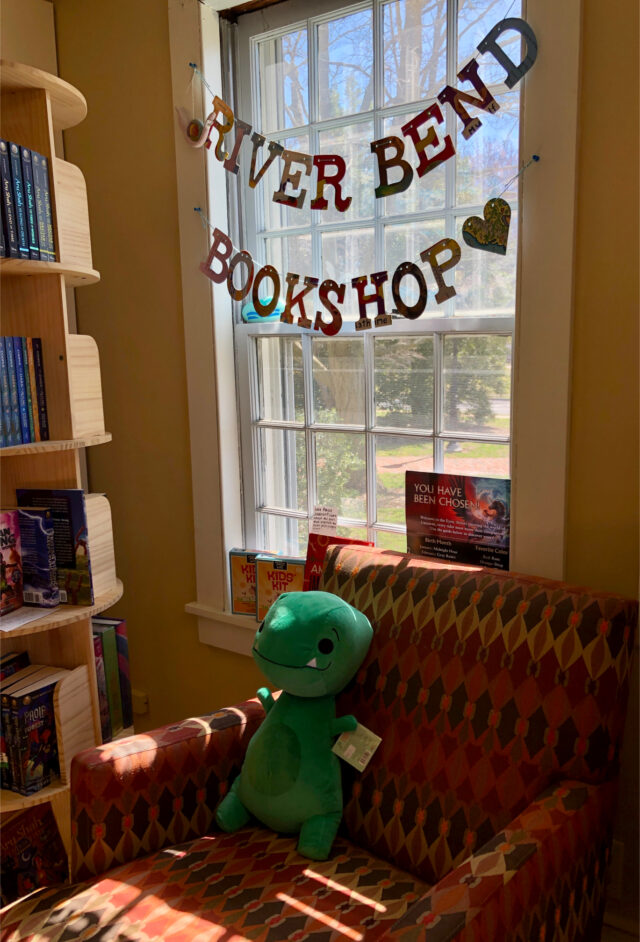
GETTING THERE: From Hartford, use the CTtransit 95 bus.
If you’re fancy and have time on a weekday, use the 904 Glastonbury Express; it costs more, does not operate on the weekend, but you’re looking at 14 minutes from the edge of downtown Hartford to Glastonbury Center, vs. 27 minutes (or more, depending on how long it takes for people to board)
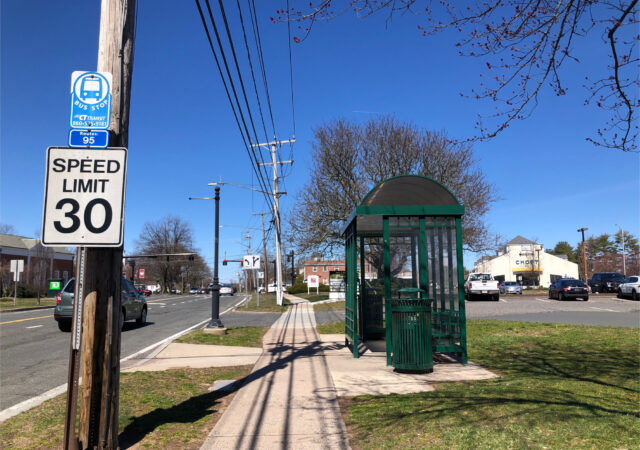

Colin Althen
I remember the tanks in Glastonbury. There are still a few along the river in East Hartford, Wethersfield, Rocky Hill, and Portland. While I think town centers are poor locations for oil tanks I do miss the idea that we shipped things on the river instead of trucks. I think the last barge I saw on the river (other than for construction) must have been 20 years ago. Unfortunately, last I heard the tanks that were taken down in Portland a few years ago may end up a parking lot. There must be a better use for riverfront than that.
I will say that the parking lot at the boat house is designed to reduce runoff into the river. The state DEP has required that for a long time and it is incorporated here, that is why there are strips of vegetation on top of the rip rap and drains incorporated at the top of the boat ramp. Any runoff is supposed to either be filtered thru vegetation or funneled to the sewer system.
On the Bike trail, I think some of that early funding went to the weird disconnected section of multi-use patch along Hebron Ave. Near Highland Park Market.